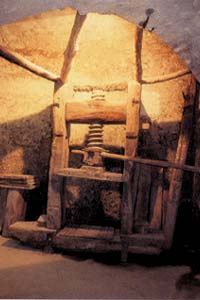« 1
| 2 |
These went ahead to the next process, the “pressatura” where using a large wooden press the remaining water was extracted and the sheets of paper passed on to the “spannituro” for the drying process.
 |
Torchio |
The “spannituro” were big empty rooms with large windows
in the highest part of the paper mill, situated over the river where they
received the maximum currents of air blowing down the valley.
Once dried they passed on to the “dell’allisciaturo”,
room where they were carefully ironed.
At the end of these procedures the sheets of paper were tied into packets ready to be sold.
The entire production was carried out by people of various professions, including the young apprentices ; the paper-mill was a large mechanism made up of men and machines under the meticulous scrutiny of the “magister in arte cartarum”, the master paper-maker.
The procedure of manufacture described has remained practically unchanged
from the Middle-Ages, the introduction of new machines “molazza”
and the “Hollanders” with the industrial revolution (XVIII)
century, only made the job of the workers lighter and quickened up some
of the procedures….
« 1
| 2 |